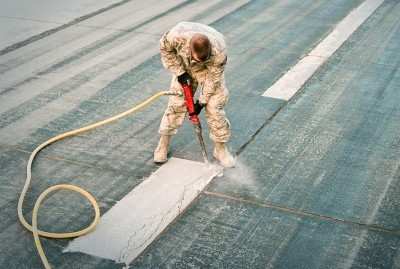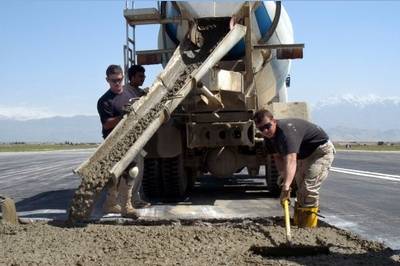Patching Runways Is A Weekly Task That Keeps Pilots And
Airplanes Flying, And Landing, Safely
Senior Airman Jacob Cleer, a heavy equipment operator assigned
to the 386th Expeditionary Civil Engineer Squadron, wrestles his
30-pound jackhammer into place and begins pounding the pavement on
one of two landing strips at an air base somewhere in the region
defined by the military as "Southwest Asia." Cleer is working on a
patch of runway that had begun to crumble a few days earlier. There
are a half-dozen other sections he is scheduled to excavate the
same day. Each of the crumbling patches, called a spall, is riddled
with fractured concrete that could damage an aircraft during
takeoffs and landings if not repaired soon.

Jacob Cleer USAF Photo
Behind him, Airman Cleer's coworkers on the 386th ECES' runway
repair team are busily mixing a cement-like mortar to pour into the
holes he's making. They'll patch the voids with a form of concrete
that cures rapidly so the runway can reopen in just three hours.
The team has been making these repairs every Friday morning since
June, when Airman Cleer and his teammates first arrived in the U.S.
Central Command Area of Operations. In those six months, the
members of the 386th ECES have repaired hundreds of spalls by
pouring more than 180 cubic feet of fresh mortar.
Spalls pose a very real danger to aircraft at the airstrip,
where thousands of takeoffs and landings happen annually as part of
24/7 airlift operations conducted by members of the 386th Air
Expeditionary Wing.
"There's always more work to do, fixing these spalls," Airman
Cleer said, rubbing his arm after several minutes of excavation.
"The jackhammer sends vibrations through your whole body, and your
elbows get pretty sore after a few hours. But you get used to it.
And this mission is the reason I'm here. We've got to
maintain."
The main imperative is speed, explained Capt. Jason Adams, the
chief of operations for the 386th ECES. "The runway is obviously a
mission-essential asset, but we have to close it to conduct repair
work," Captain Adams said. "Even though we have two runways here,
we work pretty rapidly so no runway has to be closed for an
extended period of time. Our shop can do up to 20 patches in a
single four-hour period, and the runway is available for use a few
hours after that."

File Photo
"The biggest threat that spalls pose to heavy aircraft like
C-130 (Hercules) and C-17 (Globemaster IIIs) is tire damage, which
can be pretty dangerous during landings," Captain Adams said.
"Other aircraft are much lower to the ground and can actually suck
lose concrete into the engines during takeoffs and landings,
causing millions of dollars in damage."
Preventing that kind of damage is the main point of runway
repair, he said, but the 386th ECES members' true impact is much
broader. "Our runways are where the rubber meets the road," Captain
Adams said. "Without them, the wing wouldn't be able to conduct its
airlift mission. So runway repair is about more than simply
preventing aircraft damage from loose concrete. It's also about
keeping our runways in serviceable condition, so they can stay
operational and the wing can continue to support the fight
throughout the (area of responsibility)."
Staff Sgt. Brandon Terhune, another heavy equipment operator and
runway repair specialist in the 386th ECES, said he and his
teammates draw a tremendous amount of satisfaction from that. "It's
a great feeling to know that what we're doing is making a real
difference in the mission of this wing every day," he said. "We do
our jobs very well, and I know I sleep better at night because of
that."
 ANN's Daily Aero-Term (04.14.24): Maximum Authorized Altitude
ANN's Daily Aero-Term (04.14.24): Maximum Authorized Altitude ANN's Daily Aero-Linx (04.14.24)
ANN's Daily Aero-Linx (04.14.24) Classic Aero-TV: 'We're Surviving'-- Kyle Franklin Describes Airshow Life 2013
Classic Aero-TV: 'We're Surviving'-- Kyle Franklin Describes Airshow Life 2013 Aero-News: Quote of the Day (04.14.24)
Aero-News: Quote of the Day (04.14.24) Airborne 04.09.24: SnF24!, Piper-DeltaHawk!, Fisher Update, Junkers
Airborne 04.09.24: SnF24!, Piper-DeltaHawk!, Fisher Update, Junkers




